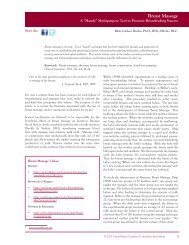Official Journal of the United States Lactation ... - Clinical Lactation
Official Journal of the United States Lactation ... - Clinical Lactation
Official Journal of the United States Lactation ... - Clinical Lactation
Create successful ePaper yourself
Turn your PDF publications into a flip-book with our unique Google optimized e-Paper software.
precisely <strong>the</strong> point. There needs to be some recognition<br />
<strong>of</strong>, and planning for, that contingency. But o<strong>the</strong>r than<br />
that, I am happy to see this recommendation included.<br />
The final point that I would like discuss is <strong>the</strong> role<br />
<strong>of</strong> breastfeeding in SIDS prevention, and how bedsharing<br />
has a role in sustaining breastfeeding. For example,<br />
Helen Ball (2007) found, in her longitudinal study <strong>of</strong> 97<br />
initially breastfed infants, that breastfeeding for at least a<br />
month was significantly associated with regular<br />
bedsharing.<br />
We, in <strong>the</strong> breastfeeding world, have been saying this for<br />
a very long time (Academy <strong>of</strong> Breastfeeding Medicine,<br />
2008; McKenna & McDade, 2005; McKenna & Volpe,<br />
2007). But now <strong>the</strong> SIDS researchers are saying it too. For<br />
example, Vennemann et al. (2009) found that breastfeeding<br />
reduced <strong>the</strong> risk <strong>of</strong> SIDS by 50%. (Yes, this is <strong>the</strong><br />
same Vennemann whose meta-analysis was cited above.)<br />
Regarding breastfeeding, Vennemann et al. (2009) said<br />
<strong>the</strong> following.<br />
We recommend including <strong>the</strong> advice to breastfeed<br />
through 6 months <strong>of</strong> age in sudden infant death<br />
syndrome risk-reduction messages (p. e406).<br />
Peter Blair and colleagues (Blair, Heron, & Fleming,<br />
2010) went fur<strong>the</strong>r and highlighted <strong>the</strong> role <strong>of</strong> bedsharing<br />
in maintaining breastfeeding. (Peter Blair is also a<br />
co-author on Vennemann et al., 2012.)<br />
Advice on whe<strong>the</strong>r bed sharing should be discouraged<br />
needs to take into account <strong>the</strong> important<br />
relationship with breastfeeding (p. 1119).<br />
So I am hopeful that we may be reaching a possible<br />
accord on this issue. While <strong>the</strong> AAP will probably never<br />
come straight out and recommend bedsharing, it would<br />
be helpful if <strong>the</strong>y acknowledged that it will likely<br />
continue, and that our role is to help all parents sleep as<br />
safely as possible—ei<strong>the</strong>r with or near <strong>the</strong>ir infants. Such<br />
a statement is possible. I’d like to close with <strong>the</strong> words<br />
from <strong>the</strong> Canadian Paediatric Society (Canadian<br />
Paediatric Society & Committee, 2004/2011).<br />
Based on <strong>the</strong> available scientific evidence, <strong>the</strong><br />
Canadian Paediatric Society recommends that for<br />
<strong>the</strong> first year <strong>of</strong> life, <strong>the</strong> safest place for babies to<br />
sleep is in <strong>the</strong>ir own crib, and in <strong>the</strong> parent’s room<br />
for <strong>the</strong> first six months. However, <strong>the</strong> Canadian<br />
Paediatric Society also acknowledges that some<br />
parents will, none<strong>the</strong>less, choose to share a bed<br />
with <strong>the</strong>ir child…..<br />
The recommended practice <strong>of</strong> independent<br />
sleeping will likely continue to be <strong>the</strong> preferred<br />
sleeping arrangement for infants in Canada, but a<br />
significant proportion <strong>of</strong> families will still elect to<br />
sleep toge<strong>the</strong>r…….<br />
The risk <strong>of</strong> suffocation and entrapment in adult<br />
beds or unsafe cribs will need to be addressed for<br />
both practices to achieve any reduction in this devastating<br />
adverse event (emphasis added).<br />
References<br />
Academy <strong>of</strong> Breastfeeding Medicine. (2008). ABM clinical protocol<br />
#6: Guideline on co-sleeping and breastfeeding. Breastfeeding<br />
Medicine, 3(1), 38-43.<br />
American Academy <strong>of</strong> Pediatrics, & Task Force on Sudden Infant<br />
Death Syndrome. (2011a). Policy Statement: SIDS and o<strong>the</strong>r<br />
sleep-related deaths: Expansion <strong>of</strong> recommendations for a safe<br />
infant sleeping environment. Pediatrics, 128(5), 1030-1039.<br />
American Academy <strong>of</strong> Pediatrics, & Task Force on Sudden Infant<br />
Death Syndrome. (2011b). Technical Report: SIDS and o<strong>the</strong>r<br />
sleep-related deaths: Expansion <strong>of</strong> recommendations for a safe<br />
infant sleeping environment. Pediatrics, 128(5), e1-e27.<br />
Kathleen Kendall-Tackett, Ph.D., IBCLC, RLC, FAPA is a health psychologist,<br />
IBCLC, and Fellow <strong>of</strong> <strong>the</strong> American Psychological Association. Dr.<br />
Kendall-Tackett is Editor-in-Chief <strong>of</strong> <strong>Clinical</strong> <strong>Lactation</strong>, clinical associate<br />
pr<strong>of</strong>essor <strong>of</strong> pediatrics at Texas Tech University Health Sciences Center,<br />
and owner <strong>of</strong> Praeclarus Press. More information on <strong>the</strong> mo<strong>the</strong>r-infant<br />
sleep debate can be found at http://praeclaruspress.com/sense-sensibility.html<br />
© 2012 <strong>United</strong> <strong>States</strong> <strong>Lactation</strong> Consultant Association 11




